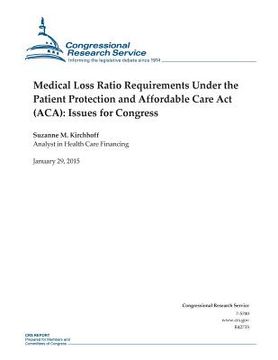Medical Loss Ratio Requirements Under the Patient Protection and Affordable Care Act (ACA): Issues for Congress (en Inglés)
Reseña del libro "Medical Loss Ratio Requirements Under the Patient Protection and Affordable Care Act (ACA): Issues for Congress (en Inglés)"
The 2010 Patient Protection and Affordable Care Act (ACA, P.L. 111-148) requires certain health insurers to provide consumer rebates if they do not meet a set financial target known as a medical loss ratio (MLR). At its most basic, a MLR measures the share of health care premium dollars spent on medical benefits, as opposed to company expenses such as overhead or profits. For example, if an insurer collects $100,000 in premiums and spends $85,000 on medical care, the MLR is 85%. In general, the higher the MLR, the more value a policyholder receives for his or her premium dollar. The ACA requires an annual, minimum 80% MLR for individual and small group insurance plans, and an annual, minimum 85% MLR for large group plans. Congress imposed the MLR to provide "greater transparency and accountability around the expenditures made by health insurers and to help bring down the cost of health care." The Department of Health and Human Services (HHS) issued rules to implement the MLR with input from state insurance commissioners, who are the main regulators of health insurance. The ACA statute and regulations allow companies to include both quality improvements and medical services when calculating total MLR medical spending. Insurers may subtract (i.e., disregard) state and local taxes and some licensing fees from total MLR expenses. The federal ACA requirements differ from many state MLR laws, which generally compare medical claims to premiums. The ACA MLR is now the national minimum standard that must be met by covered health insurers. The ACA MLR is based on an insurer's annual aggregate performance, not on each individual's policy history. A consumer who paid health insurance premiums but did not file any medical claims during a plan year would not qualify for a rebate if his or her insurer met minimum MLR requirements. In addition, many Americans are enrolled in health plans that are not covered by the ACA MLR. The MLR provisions apply to fully funded health plans, which are plans where insurance companies assume full risk for incurred medical expenses. The MLR does not extend to self-funded plans, which are health care plans offered by businesses where the employer assumes the risk for, and pays for, medical care. Medicare plans were not subject to the MLR during the first two years the ACA was in effect. These insurers began complying with MLR provisions beginning in calendar 2014. The HHS granted three-year MLR waivers to select states where it determined that MLR implementation could harm the individual insurance market. Congress included language in the Consolidated and Further Continuing Appropriations Act of 2015 (H.R. 83, P.L. 113-235) exempting expatriate insurance plans from MLR reporting requirements. For the 2013 plan year, insurers owed $332 million in MLR rebate payments to 6.8 million consumers. That is significantly less than the $1.1 billion in rebates to 12.8 million individuals in 2011, the first year the MLR was in effect. Insurers and employers may provide the rebates via a check, an electronic deposit in a bank account, a reduction in insurance premiums, or by spending the funds for the benefit of employees. Lawmakers have raised some concerns about the MLR provisions, including the fact that insurers are not allowed to deduct insurance agent and broker bonuses and commissions from their MLR expenses.

